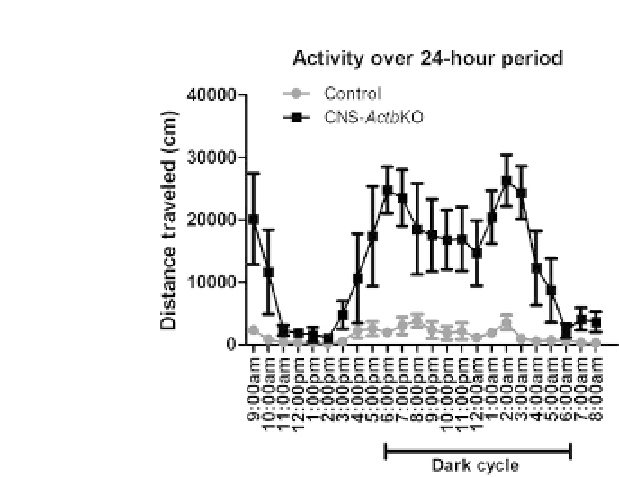Biology Reference
In-Depth Information
Figure 4.5
Activity levels of CNS-ActbKO mice over a 24-h period.
CNS-
Actb
KO mice were
significantly more active than control mice over a 24-h period but did show activity pat-
terns consistent with a normal circadian rhythm. Data represent mean ± standard error
of the mean.
n
= 4 mice per genotype.
indeed histologically normal, the relatively simple and high-throughput
open field activity assay could be performed to ascertain the relative
extent that the large-scale morphological abnormalities contributed to
the functional effects observed in CNS-
Actb
KO mice. In addition, the
use of the CNS-
Actg1
KO mouse model, which does not exhibit hippo-
campal or any other morphological brain abnormalities, could provide
an additional control. The normal development of the hippocampus but
persistence of behavioral phenotypes would suggest that localized defects
at synapses and perhaps dendritic spines may be the primary mechanism
behind the observed behavioral abnormalities in the absence of β-actin.
Perhaps the most surprising behavioral defect observed in the CNS-
Actb
KO mice was a profound maternal behavior deficit. No pup born to a
CNS-
Actb
KO mother survived for longer than 1 day regardless of genotype,
which also correlated with an apparent pup retrieval defect (
Cheever et al.,
2012
). Neonatal mice are unable to completely regulate internal body tem-
perature, and are thus dependent on retrieval into a nest to maintain body
temperature. The CNS-
Actb
KO pup retrieval deficit was independent of
the pups, as the same litter was retrieved and cared for normally when fos-
tered to a control mother. The specific mechanism or mechanisms underly-
ing this phenotype are at present unclear, although there are a number of
intriguing possibilities.

Search WWH ::

Custom Search